

Compact Muon Solenoid
LHC, CERN
| CMS-PAS-HIG-21-019 | ||
| Measurement of the Higgs boson mass and width using the four leptons final state | ||
| CMS Collaboration | ||
| 20 September 2023 | ||
| Abstract: A measurement of the Higgs boson mass and width using the decays to two Z bosons is presented, using the proton-proton data collected by the CMS experiment at the LHC corresponding to an integrated luminosity of 138 fb−1 at a center-of-mass energy of 13 TeV. The on-shell production of the Higgs boson with the decay H→ZZ∗→4ℓ is used to constrain its mass and width, which yields to the most precise single measurement of the mass to date mH= 125.08 ± 0.12 GeV and an upper limit on the width ΓH< 60 MeV at 68% confidence level. A combination of the on-shell and off-shell production of the Higgs boson is used to constrain its width, leading to the observed measurement on the width 2.9 +2.3−1.7 MeV, in agreement with the standard model prediction of 4.1 MeV. The strength of the off-shell Higgs boson production is also reported. | ||
|
Links:
CDS record (PDF) ;
CADI line (restricted) ;
These preliminary results are superseded in this paper, Submitted to PRD. The superseded preliminary plots can be found here. |
||
| Figures & Tables | Summary | Additional Figures & Tables | References | CMS Publications |
|---|
| Figures | |
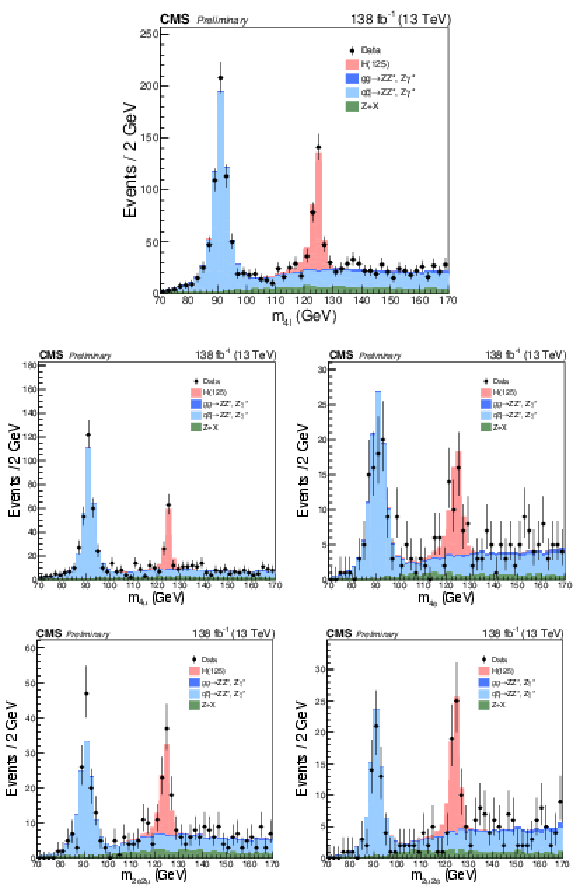
png pdf |
Figure 1:
Observed data and the expected pre-fit distributions of the four-lepton invariant mass in the inclusive (top), 4μ (middle left), 4e (middle right), 2e2μ (bottom left) and 2μ2e (bottom right) final states. |
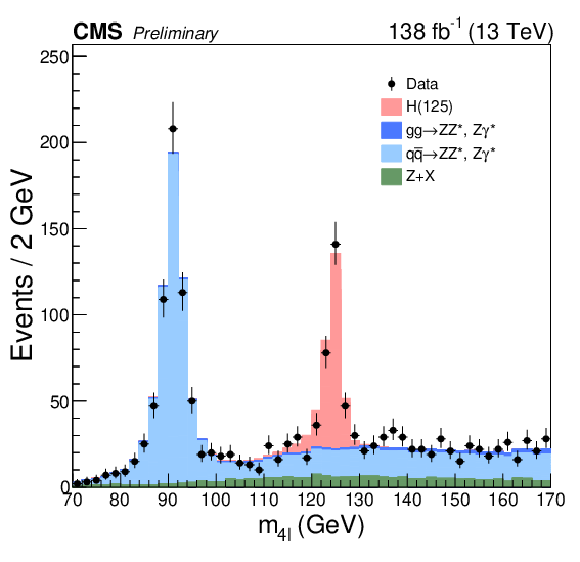
png pdf |
Figure 1-a:
Observed data and the expected pre-fit distributions of the four-lepton invariant mass in the inclusive (top), 4μ (middle left), 4e (middle right), 2e2μ (bottom left) and 2μ2e (bottom right) final states. |

png pdf |
Figure 1-b:
Observed data and the expected pre-fit distributions of the four-lepton invariant mass in the inclusive (top), 4μ (middle left), 4e (middle right), 2e2μ (bottom left) and 2μ2e (bottom right) final states. |

png pdf |
Figure 1-c:
Observed data and the expected pre-fit distributions of the four-lepton invariant mass in the inclusive (top), 4μ (middle left), 4e (middle right), 2e2μ (bottom left) and 2μ2e (bottom right) final states. |

png pdf |
Figure 1-d:
Observed data and the expected pre-fit distributions of the four-lepton invariant mass in the inclusive (top), 4μ (middle left), 4e (middle right), 2e2μ (bottom left) and 2μ2e (bottom right) final states. |

png pdf |
Figure 1-e:
Observed data and the expected pre-fit distributions of the four-lepton invariant mass in the inclusive (top), 4μ (middle left), 4e (middle right), 2e2μ (bottom left) and 2μ2e (bottom right) final states. |

png pdf |
Figure 2:
Observed data and the expected pre-fit distribution of the relative per-event mass uncertainty of the four-lepton system, in the inclusive final state, in the region of interest with 105 <m4ℓ< 140 GeV. |
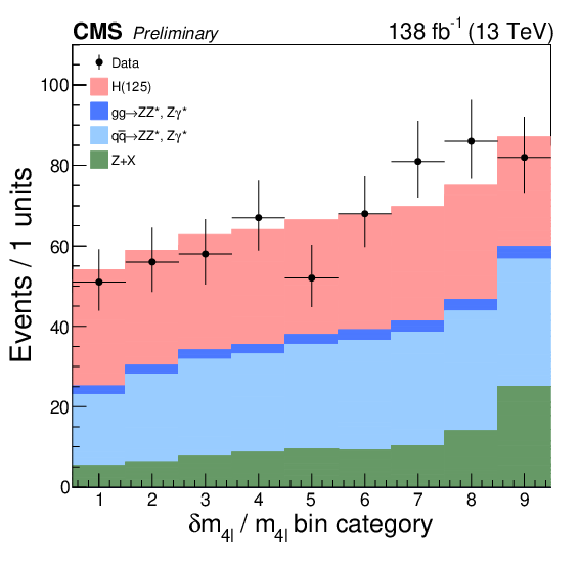
png pdf |
Figure 3:
Observed data and expected pre-fit distribution of the relative per-event mass uncertainty of the four-lepton system, inclusively for all considered final states. The bins are shown in the order of increasing δm4ℓ/m4ℓ, in the region of interest with 105 <m4ℓ< 140 GeV. |

png pdf |
Figure 4:
Observed data and pre-fit distribution of Dkinbkg of the four-leptons system, in the inclusive final state, in the region of interest of 105 <m4ℓ< 140 GeV. |
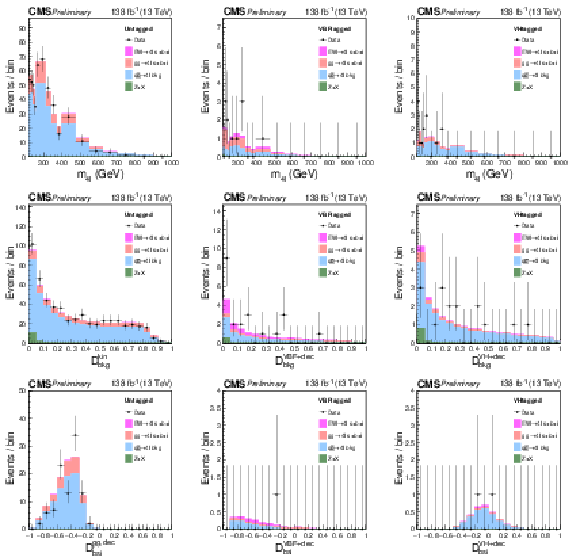
png pdf |
Figure 5:
Observed data and pre-fit distributions of events in the off-shell region, in the Untagged (left column), VBF-tagged (middle column), and VH-tagged (right column) categories. The top row shows m4ℓ where a requirement on Dkinbkg, DVBF+decbkg or DVH+decbkg> 0.6 is applied in order to enhance signal over background contributions. The middle row shows Dkinbkg (left), DVBF+decbkg (middle), DVH+decbkg (right). The requirement m4ℓ> 340 GeV is applied in order to enhance signal over background contributions. The bottom row shows Dbsi with both of the m4ℓ and Dkinbkg requirements enhancing the signal contribution. |
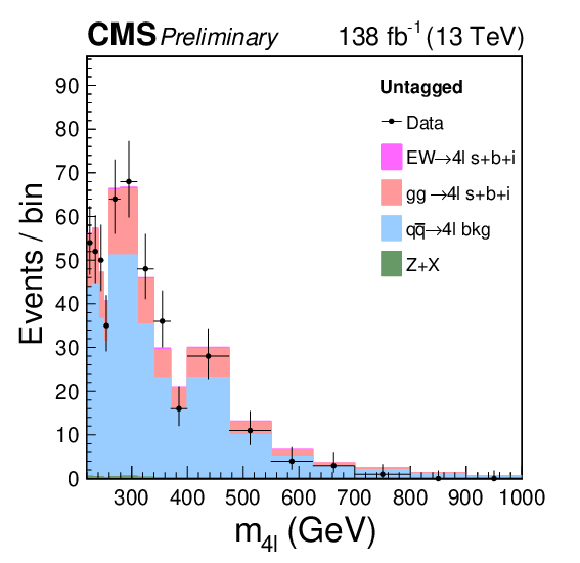
png pdf |
Figure 5-a:
Observed data and pre-fit distributions of events in the off-shell region, in the Untagged (left column), VBF-tagged (middle column), and VH-tagged (right column) categories. The top row shows m4ℓ where a requirement on Dkinbkg, DVBF+decbkg or DVH+decbkg> 0.6 is applied in order to enhance signal over background contributions. The middle row shows Dkinbkg (left), DVBF+decbkg (middle), DVH+decbkg (right). The requirement m4ℓ> 340 GeV is applied in order to enhance signal over background contributions. The bottom row shows Dbsi with both of the m4ℓ and Dkinbkg requirements enhancing the signal contribution. |
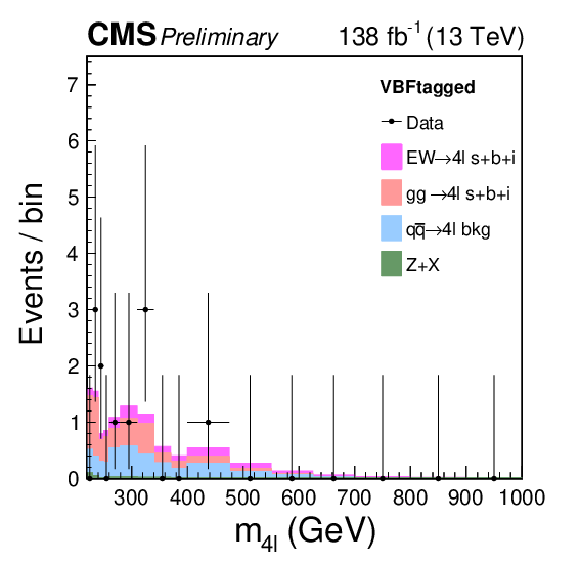
png pdf |
Figure 5-b:
Observed data and pre-fit distributions of events in the off-shell region, in the Untagged (left column), VBF-tagged (middle column), and VH-tagged (right column) categories. The top row shows m4ℓ where a requirement on Dkinbkg, DVBF+decbkg or DVH+decbkg> 0.6 is applied in order to enhance signal over background contributions. The middle row shows Dkinbkg (left), DVBF+decbkg (middle), DVH+decbkg (right). The requirement m4ℓ> 340 GeV is applied in order to enhance signal over background contributions. The bottom row shows Dbsi with both of the m4ℓ and Dkinbkg requirements enhancing the signal contribution. |
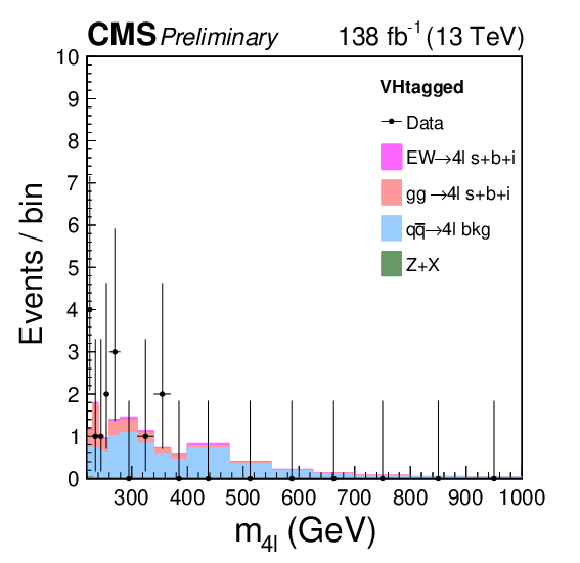
png pdf |
Figure 5-c:
Observed data and pre-fit distributions of events in the off-shell region, in the Untagged (left column), VBF-tagged (middle column), and VH-tagged (right column) categories. The top row shows m4ℓ where a requirement on Dkinbkg, DVBF+decbkg or DVH+decbkg> 0.6 is applied in order to enhance signal over background contributions. The middle row shows Dkinbkg (left), DVBF+decbkg (middle), DVH+decbkg (right). The requirement m4ℓ> 340 GeV is applied in order to enhance signal over background contributions. The bottom row shows Dbsi with both of the m4ℓ and Dkinbkg requirements enhancing the signal contribution. |
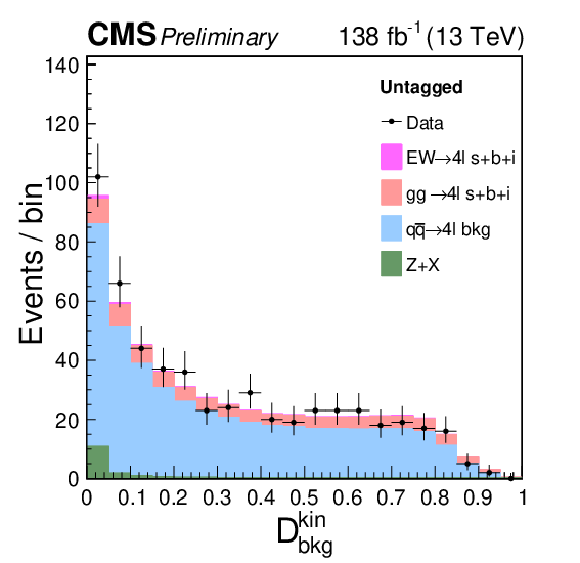
png pdf |
Figure 5-d:
Observed data and pre-fit distributions of events in the off-shell region, in the Untagged (left column), VBF-tagged (middle column), and VH-tagged (right column) categories. The top row shows m4ℓ where a requirement on Dkinbkg, DVBF+decbkg or DVH+decbkg> 0.6 is applied in order to enhance signal over background contributions. The middle row shows Dkinbkg (left), DVBF+decbkg (middle), DVH+decbkg (right). The requirement m4ℓ> 340 GeV is applied in order to enhance signal over background contributions. The bottom row shows Dbsi with both of the m4ℓ and Dkinbkg requirements enhancing the signal contribution. |

png pdf |
Figure 5-e:
Observed data and pre-fit distributions of events in the off-shell region, in the Untagged (left column), VBF-tagged (middle column), and VH-tagged (right column) categories. The top row shows m4ℓ where a requirement on Dkinbkg, DVBF+decbkg or DVH+decbkg> 0.6 is applied in order to enhance signal over background contributions. The middle row shows Dkinbkg (left), DVBF+decbkg (middle), DVH+decbkg (right). The requirement m4ℓ> 340 GeV is applied in order to enhance signal over background contributions. The bottom row shows Dbsi with both of the m4ℓ and Dkinbkg requirements enhancing the signal contribution. |
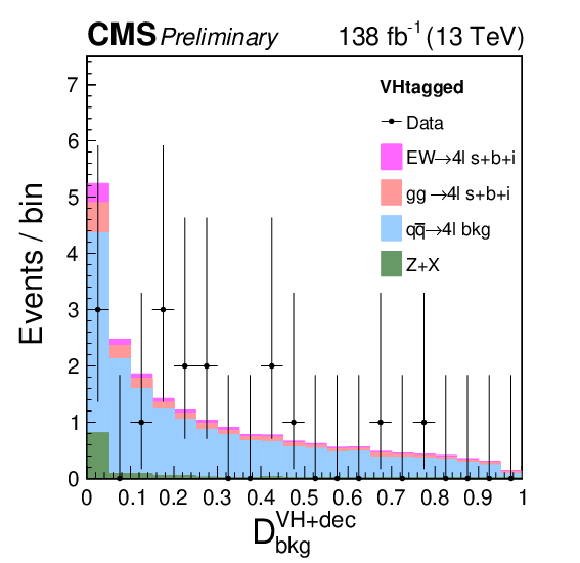
png pdf |
Figure 5-f:
Observed data and pre-fit distributions of events in the off-shell region, in the Untagged (left column), VBF-tagged (middle column), and VH-tagged (right column) categories. The top row shows m4ℓ where a requirement on Dkinbkg, DVBF+decbkg or DVH+decbkg> 0.6 is applied in order to enhance signal over background contributions. The middle row shows Dkinbkg (left), DVBF+decbkg (middle), DVH+decbkg (right). The requirement m4ℓ> 340 GeV is applied in order to enhance signal over background contributions. The bottom row shows Dbsi with both of the m4ℓ and Dkinbkg requirements enhancing the signal contribution. |
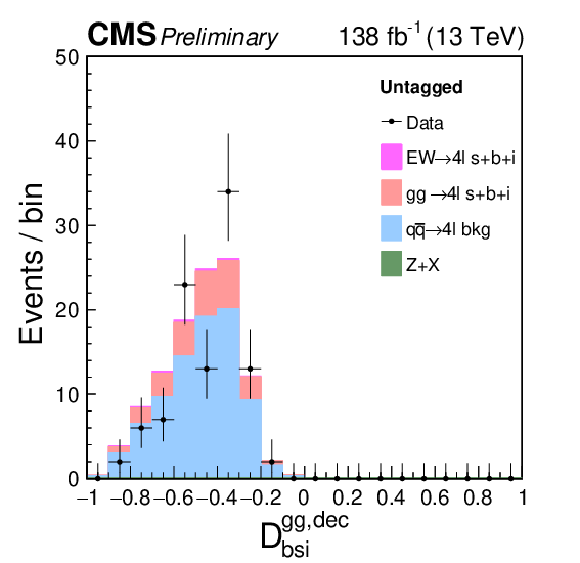
png pdf |
Figure 5-g:
Observed data and pre-fit distributions of events in the off-shell region, in the Untagged (left column), VBF-tagged (middle column), and VH-tagged (right column) categories. The top row shows m4ℓ where a requirement on Dkinbkg, DVBF+decbkg or DVH+decbkg> 0.6 is applied in order to enhance signal over background contributions. The middle row shows Dkinbkg (left), DVBF+decbkg (middle), DVH+decbkg (right). The requirement m4ℓ> 340 GeV is applied in order to enhance signal over background contributions. The bottom row shows Dbsi with both of the m4ℓ and Dkinbkg requirements enhancing the signal contribution. |
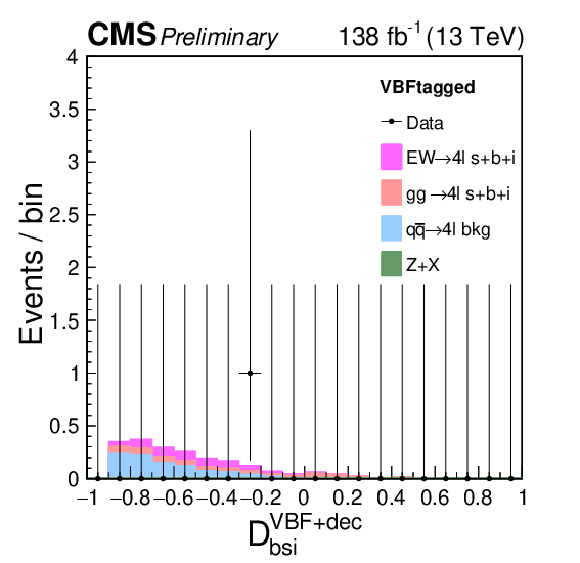
png pdf |
Figure 5-h:
Observed data and pre-fit distributions of events in the off-shell region, in the Untagged (left column), VBF-tagged (middle column), and VH-tagged (right column) categories. The top row shows m4ℓ where a requirement on Dkinbkg, DVBF+decbkg or DVH+decbkg> 0.6 is applied in order to enhance signal over background contributions. The middle row shows Dkinbkg (left), DVBF+decbkg (middle), DVH+decbkg (right). The requirement m4ℓ> 340 GeV is applied in order to enhance signal over background contributions. The bottom row shows Dbsi with both of the m4ℓ and Dkinbkg requirements enhancing the signal contribution. |
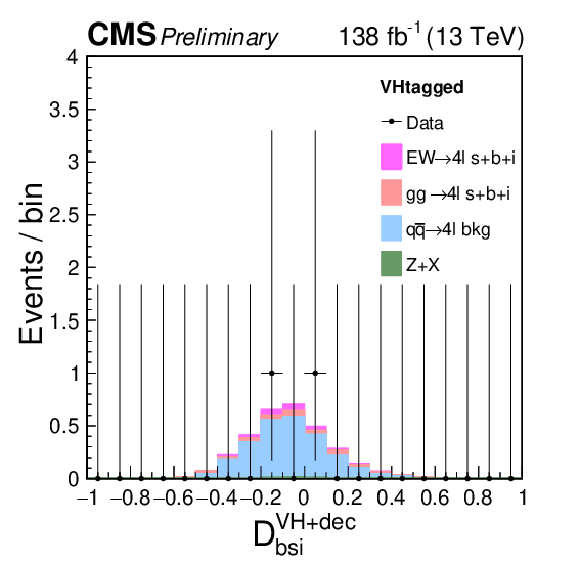
png pdf |
Figure 5-i:
Observed data and pre-fit distributions of events in the off-shell region, in the Untagged (left column), VBF-tagged (middle column), and VH-tagged (right column) categories. The top row shows m4ℓ where a requirement on Dkinbkg, DVBF+decbkg or DVH+decbkg> 0.6 is applied in order to enhance signal over background contributions. The middle row shows Dkinbkg (left), DVBF+decbkg (middle), DVH+decbkg (right). The requirement m4ℓ> 340 GeV is applied in order to enhance signal over background contributions. The bottom row shows Dbsi with both of the m4ℓ and Dkinbkg requirements enhancing the signal contribution. |
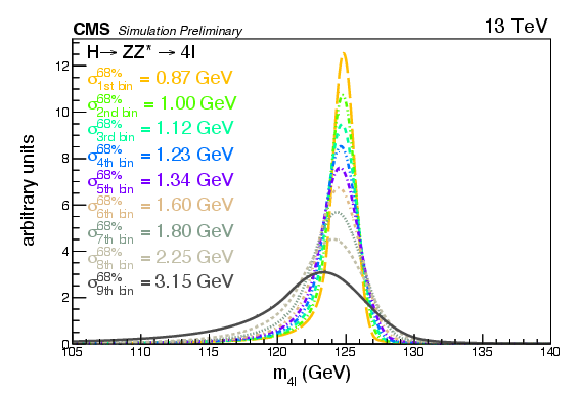
png pdf |
Figure 6:
Illustration of how the signal model for the fit changes with the δm4ℓ/m4ℓ bins, merging all final state. The resolution estimator σ68%, defined as the Gaussian width used to fit the smallest invariant mass window containing 68% of the signal events, is also listed for each bin. |
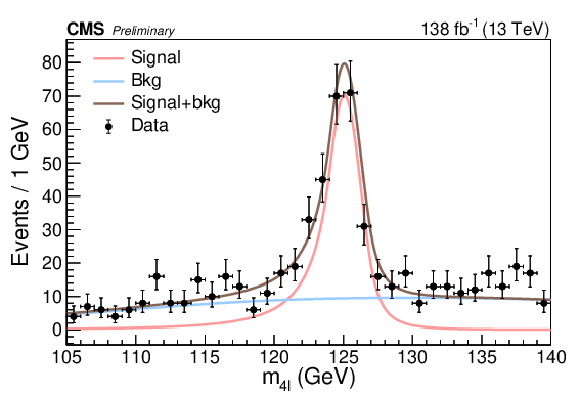
png pdf |
Figure 7:
Illustration of how the statistical model is constructed, combining all years and all final states. The light red line shows the signal, the light blue line shows the background and the brown line represents their sum. The solid black points with error bars show the data. |
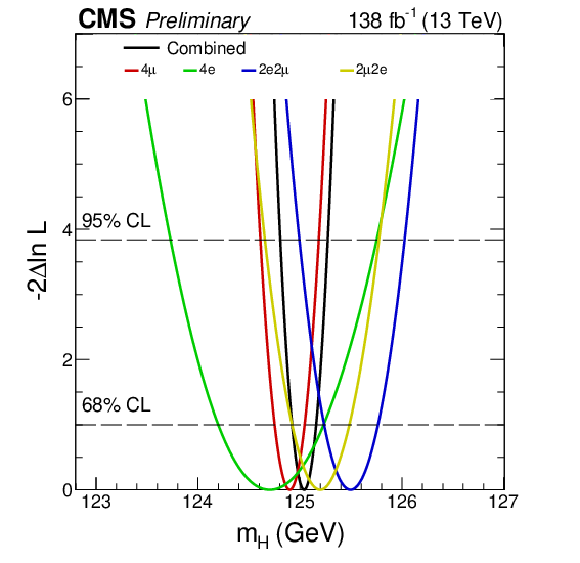
png pdf |
Figure 8:
Observed profile likelihood projection on mH, split per final state and combined, using N-2D′VXBS approach. Both statistical and systematic uncertainties have been considered. |

png pdf |
Figure 9:
Summary of the observed CMS H boson mass measurements using the four-lepton final state. The red vertical line and the grey column represent the best fit value and the total uncertainty respectively as measured from the Run 1 and Run 2 combination. The yellow bands stands for the statistical uncertainty and the black error bars for the total uncertainty. |
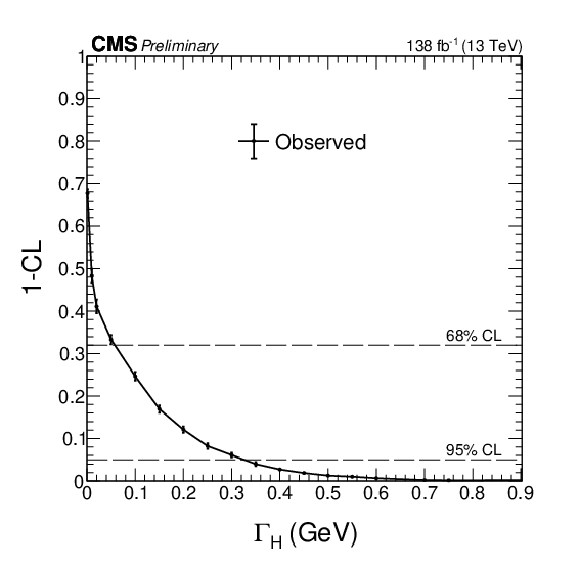
png pdf |
Figure 10:
1−CL extracted from Feldman-Cousins approach (black dots). A linear interpolation through the points is also shown.The error bars represent the spread of the simulated experiments for each point. |

png pdf |
Figure 11:
Observed and expected profile likelihood projection on the H boson width using the on-shell and off-shell production. |

png pdf |
Figure 12:
Observed 2D profile likelihood projection on the off-shell signal strength (μoff-shell F,μoff-shell V). |
| Tables | |

png pdf |
Table 1:
Summary of the three production categories in the off-shell m4ℓ region. All discriminants are calculated with the JHUGEN signal and MCFM background matrix elements. The VH interference discriminant in the VH-tagged category is defined as the simple average of the ones corresponding to the ZH and WH processes. |
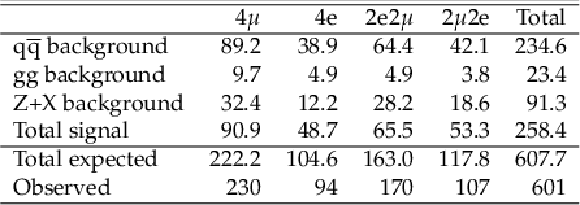
png pdf |
Table 2:
The observed number of events and the post-fit expected yields for the H boson signal and background contributions in the on-shell region 105 <m4ℓ< 140 GeV. |

png pdf |
Table 3:
Observed number of events and post-fit expections for the H boson signal and background contributions in the off-shell region m4ℓ> 220 GeV. |

png pdf |
Table 4:
Best fit values for the mass of the H boson measured in the inclusive 4ℓ final state and split for different flavor states using 1D only approach. Uncertainties are separated into statistical and systematic uncertainties, with the first one representing the statistical uncertainty. Expected results are obtained considering the hypothesis mH= 125.38 GeV. |
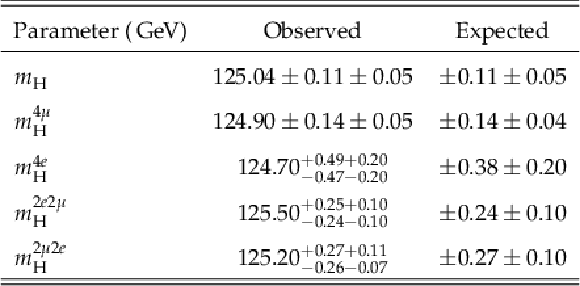
png pdf |
Table 5:
Best fit values for the mass of the H boson measured in different 4ℓ final states, in the final configuration (N−2D′VXBS). Uncertainties in the measurement results are presented separately as statistical and systematic uncertainties, where the first one refers to statistical uncertainty. Expected results are obtained considering the hypothesis mH= 125.38 GeV. |

png pdf |
Table 6:
Summary of the mass and total width ΓH measurements, showing the allowed 68% CL (central values with uncertainties) and 95% CL (in square brackets) intervals. Uncertainties are reported as a combination of statistical and systematic uncertainties. In the on-shell result, the width is restricted to be positive. |

png pdf |
Table 7:
Summary of allowed 68% CL (central values with uncertainties) and 95% CL (in square brackets) intervals for μoff-shell , μoff-shell F, and μoff-shell V |
| Summary |
| A measurement of the H boson mass and width is presented using the decays to two Z bosons, using the data recorded with the CMS experiment at a center-of-mass energy of 13 TeV, corresponding to an integrated luminosity of 138 fb−1. The on-shell production of the H boson with the decay H→4ℓ is used to constrain its mass and width, leading to the most precise single measurement of the mass to date in this channel: mH= 125.08 ± 0.12 GeV = 125.08 ± 0.10 (stat.) ± 0.07 (syst.) GeV in agreement with the expected precision of ± 0.12 GeV. The width constraint from the on-shell production only is ΓH< 60 MeV at 68% CL. A combination of the on-shell and off-shell production of the H boson is used to constrain its width, leading to the observed measurement on the width ΓH= 2.9 +2.3−1.7 MeV, in agreement with the standard model prediction of 4.1 MeV. The strength of the off-shell H boson production is also reported. |
| Additional Figures | |

png pdf |
Additional Figure 1:
Comparison of the four-lepton invariant mass line shape with (red) and without (blue) the beam spot contraint, split per final state, merging all years. Top row: 4μ and 4e; bottom row: 2e2μ and 2μ2e. σ68%, defined as the Gaussian width used to fit the smallest invariant mass window containing 68% of the signal event, is also shown. |

png pdf |
Additional Figure 1-a:
Comparison of the four-lepton invariant mass line shape with (red) and without (blue) the beam spot contraint, split per final state, merging all years. Top row: 4μ and 4e; bottom row: 2e2μ and 2μ2e. σ68%, defined as the Gaussian width used to fit the smallest invariant mass window containing 68% of the signal event, is also shown. |

png pdf |
Additional Figure 1-b:
Comparison of the four-lepton invariant mass line shape with (red) and without (blue) the beam spot contraint, split per final state, merging all years. Top row: 4μ and 4e; bottom row: 2e2μ and 2μ2e. σ68%, defined as the Gaussian width used to fit the smallest invariant mass window containing 68% of the signal event, is also shown. |
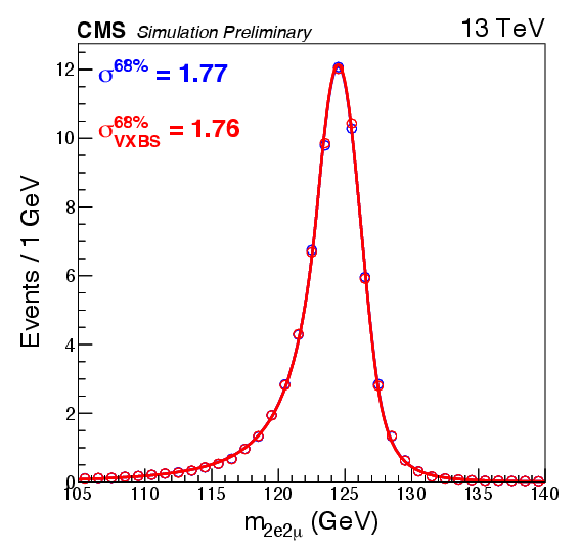
png pdf |
Additional Figure 1-c:
Comparison of the four-lepton invariant mass line shape with (red) and without (blue) the beam spot contraint, split per final state, merging all years. Top row: 4μ and 4e; bottom row: 2e2μ and 2μ2e. σ68%, defined as the Gaussian width used to fit the smallest invariant mass window containing 68% of the signal event, is also shown. |

png pdf |
Additional Figure 1-d:
Comparison of the four-lepton invariant mass line shape with (red) and without (blue) the beam spot contraint, split per final state, merging all years. Top row: 4μ and 4e; bottom row: 2e2μ and 2μ2e. σ68%, defined as the Gaussian width used to fit the smallest invariant mass window containing 68% of the signal event, is also shown. |
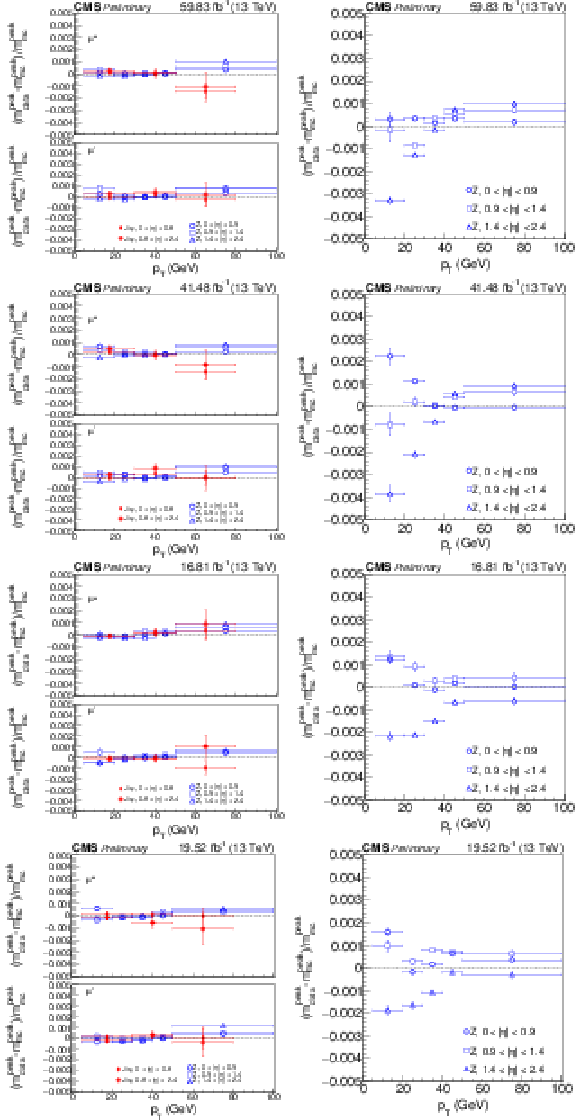
png pdf |
Additional Figure 2:
Difference between data and simulation in Z(J/ψ)→2ℓ, normalized to simulation, as a function of pT and |η| for muons (left) and electron (right), regardless of the second lepton. From top to bottom: 2018, 2017, 2016 pre- and post-VFP. |

png pdf |
Additional Figure 2-a:
Difference between data and simulation in Z(J/ψ)→2ℓ, normalized to simulation, as a function of pT and |η| for muons (left) and electron (right), regardless of the second lepton. From top to bottom: 2018, 2017, 2016 pre- and post-VFP. |

png pdf |
Additional Figure 2-b:
Difference between data and simulation in Z(J/ψ)→2ℓ, normalized to simulation, as a function of pT and |η| for muons (left) and electron (right), regardless of the second lepton. From top to bottom: 2018, 2017, 2016 pre- and post-VFP. |

png pdf |
Additional Figure 2-c:
Difference between data and simulation in Z(J/ψ)→2ℓ, normalized to simulation, as a function of pT and |η| for muons (left) and electron (right), regardless of the second lepton. From top to bottom: 2018, 2017, 2016 pre- and post-VFP. |

png pdf |
Additional Figure 2-d:
Difference between data and simulation in Z(J/ψ)→2ℓ, normalized to simulation, as a function of pT and |η| for muons (left) and electron (right), regardless of the second lepton. From top to bottom: 2018, 2017, 2016 pre- and post-VFP. |
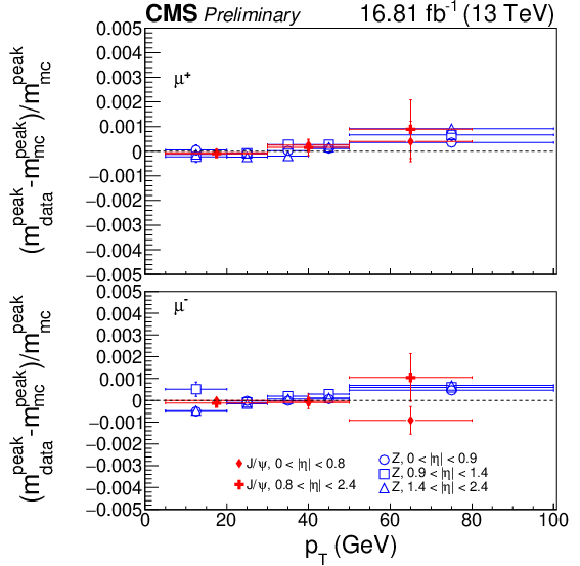
png pdf |
Additional Figure 2-e:
Difference between data and simulation in Z(J/ψ)→2ℓ, normalized to simulation, as a function of pT and |η| for muons (left) and electron (right), regardless of the second lepton. From top to bottom: 2018, 2017, 2016 pre- and post-VFP. |
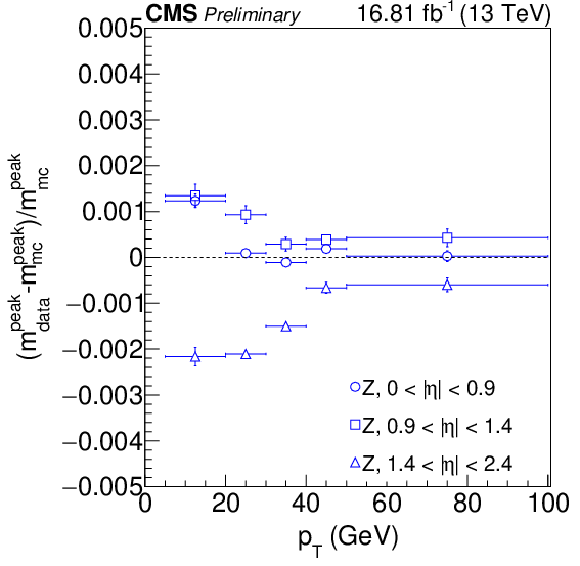
png pdf |
Additional Figure 2-f:
Difference between data and simulation in Z(J/ψ)→2ℓ, normalized to simulation, as a function of pT and |η| for muons (left) and electron (right), regardless of the second lepton. From top to bottom: 2018, 2017, 2016 pre- and post-VFP. |

png pdf |
Additional Figure 2-g:
Difference between data and simulation in Z(J/ψ)→2ℓ, normalized to simulation, as a function of pT and |η| for muons (left) and electron (right), regardless of the second lepton. From top to bottom: 2018, 2017, 2016 pre- and post-VFP. |

png pdf |
Additional Figure 2-h:
Difference between data and simulation in Z(J/ψ)→2ℓ, normalized to simulation, as a function of pT and |η| for muons (left) and electron (right), regardless of the second lepton. From top to bottom: 2018, 2017, 2016 pre- and post-VFP. |

png pdf |
Additional Figure 3:
The observed (expected) likelihood scan as a function of mH is shown in black (red) using the N−2D′VXBS approach. The scans are shown both with (solid line) and without (dashed line) systematic uncertainties. Expected likelihood has been obtained with the hypothesis mH= 125.38 GeV and then shifted towards the observed central value of 125.04 GeV. |
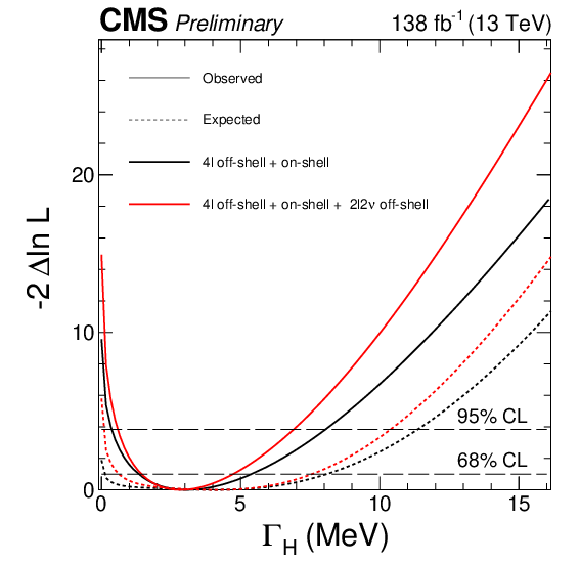
png pdf |
Additional Figure 4:
Observed (solid) and expected (dashed) profile likelihood projection on the H boson width using the on-shell and off-shell production. The analysis of H→4ℓ off-shell combined with the H→4ℓ on-shell channel is shown in black and the full combination of H→4ℓ on-shell and off-shell with H→2ℓ2ν off-shell is shown in red. The zero off-shell H production hypothesis is excluded at a 3.9 standard deviations confidence level. |
| Additional Tables | |

png pdf |
Additional Table 1:
Features of the different approaches used in the on-shell analysis. |
| References | ||||
| 1 | S. L. Glashow | Partial-symmetries of weak interactions | NP 22 (1961) 579 | |
| 2 | F. Englert and R. Brout | Broken symmetry and the mass of gauge vector mesons | PRL 13 (1964) 321 | |
| 3 | P. W. Higgs | Broken symmetries, massless particles and gauge fields | PL 12 (1964) 132 | |
| 4 | P. W. Higgs | Broken symmetries and the masses of gauge bosons | PRL 13 (1964) 508 | |
| 5 | G. S. Guralnik, C. R. Hagen, and T. W. B. Kibble | Global conservation laws and massless particles | PRL 13 (1964) 585 | |
| 6 | S. Weinberg | A model of leptons | PRL 19 (1967) 1264 | |
| 7 | A. Salam | Weak and electromagnetic interactions | in Elementary particle physics: relativistic groups and analyticity, N. Svartholm, ed., Almqvist & Wiksell, Stockholm, Proceedings of the eighth Nobel symposium, 1968 | |
| 8 | ATLAS Collaboration | Observation of a new particle in the search for the Standard Model Higgs boson with the ATLAS detector at the LHC | PLB 716 (2012) 1 | 1207.7214 |
| 9 | CMS Collaboration | Observation of a new boson at a mass of 125 GeV with the CMS experiment at the LHC | PLB 716 (2012) 30 | CMS-HIG-12-028 1207.7235 |
| 10 | CMS Collaboration | Observation of a new boson with mass near 125 GeV in pp collisions at √s= 7 and 8 TeV | JHEP 06 (2013) 081 | CMS-HIG-12-036 1303.4571 |
| 11 | ATLAS and CMS Collaborations | Combined Measurement of the Higgs Boson Mass in pp Collisions at √s= 7 and 8 TeV with the ATLAS and CMS Experiments | PRL 114 (2015) 191803 | 1503.07589 |
| 12 | ATLAS Collaboration | Combined measurement of the Higgs boson mass from the H→γγ and H→ZZ∗→4ℓ decay channels with the ATLAS detector using √s = 7, 8 and 13 TeV pp collision data | 2308.04775 | |
| 13 | CMS Collaboration | A measurement of the Higgs boson mass in the diphoton decay channel | PLB 805 (2020) 135425 | CMS-HIG-19-004 2002.06398 |
| 14 | CMS Collaboration | Precise determination of the mass of the Higgs boson and tests of compatibility of its couplings with the standard model predictions using proton collisions at 7 and 8 TeV | EPJC 75 (2015) 212 | CMS-HIG-14-009 1412.8662 |
| 15 | ATLAS Collaboration | Measurement of the Higgs boson mass from the H→γγ and H→ZZ∗→4ℓ channels with the ATLAS detector using 25 fb−1 of pp collision data | PRD 90 (2014) 052004 | 1406.3827 |
| 16 | CMS Collaboration | Measurements of properties of the Higgs boson decaying into the four-lepton final state in pp collisions at √s= 13 TeV | JHEP 11 (2017) 047 | CMS-HIG-16-041 1706.09936 |
| 17 | CMS Collaboration | Constraints on the Higgs boson width from off-shell production and decay to Z-boson pairs | PLB 736 (2014) 64 | CMS-HIG-14-002 1405.3455 |
| 18 | ATLAS Collaboration | Constraints on the off-shell Higgs boson signal strength in the high-mass ZZ and WW final states with the ATLAS detector | EPJC 75 (2015) 335 | 1503.01060 |
| 19 | CMS Collaboration | Limits on the Higgs boson lifetime and width from its decay to four charged leptons | PRD 92 (2015) 072010 | CMS-HIG-14-036 1507.06656 |
| 20 | CMS Collaboration | Search for Higgs boson off-shell production in proton-proton collisions at 7 and 8 TeV and derivation of constraints on its total decay width | JHEP 09 (2016) 051 | CMS-HIG-14-032 1605.02329 |
| 21 | ATLAS Collaboration | Constraints on off-shell Higgs boson production and the Higgs boson total width in ZZ→4ℓ and ZZ→2ℓ2ν final states with the ATLAS detector | PLB 786 (2018) 223 | 1808.01191 |
| 22 | CMS Collaboration | Measurements of the Higgs boson width and anomalous HVV couplings from on-shell and off-shell production in the four-lepton final state | Phys. Rev. D 11200 (2019) 3 | CMS-HIG-18-002 1901.00174 |
| 23 | CMS Collaboration | Measurement of the Higgs boson width and evidence of its off-shell contributions to ZZ production | Nature Phys. 18 (2022) 1329 | CMS-HIG-21-013 2202.06923 |
| 24 | F. Caola and K. Melnikov | Constraining the Higgs boson width with ZZ production at the LHC | PRD 88 (2013) 054024 | 1307.4935 |
| 25 | N. Kauer and G. Passarino | Inadequacy of zero-width approximation for a light Higgs boson signal | JHEP 08 (2012) 116 | 1206.4803 |
| 26 | J. M. Campbell, R. K. Ellis, and C. Williams | Bounding the Higgs width at the LHC using full analytic results for gg→e−e+μ−μ+ | JHEP 04 (2014) 060 | 1311.3589 |
| 27 | ATLAS Collaboration | Evidence of off-shell Higgs boson production from ZZ leptonic decay channels and constraints on its total width with the ATLAS detector | ||
| 28 | LHC Higgs Cross Section Working Group | Handbook of LHC Higgs cross sections: 4. deciphering the nature of the Higgs sector | CERN, 2016 link |
1610.07922 |
| 29 | CMS Collaboration | The CMS experiment at the CERN LHC | JINST 3 (2008) S08004 | |
| 30 | CMS Collaboration | Performance of the CMS Level-1 trigger in proton-proton collisions at √s= 13 TeV | JINST 15 (2020) P10017 | CMS-TRG-17-001 2006.10165 |
| 31 | CMS Collaboration | The CMS trigger system | JINST 12 (2017) P01020 | CMS-TRG-12-001 1609.02366 |
| 32 | CMS Collaboration | Measurements of production cross sections of the Higgs boson in the four-lepton final state in proton-proton collisions at √s= 13 TeV | EPJC 81 (2021) 488 | CMS-HIG-19-001 2103.04956 |
| 33 | T. Sjöstrand et al. | An introduction to PYTHIA 8.2 | Comput. Phys. Commun. 191 (2015) 159 | 1410.3012 |
| 34 | CMS Collaboration | Event generator tunes obtained from underlying event and multiparton scattering measurements | EPJC 76 (2016) 155 | CMS-GEN-14-001 1512.00815 |
| 35 | CMS Collaboration | Extraction and validation of a new set of CMS PYTHIA8 tunes from underlying-event measurements | EPJC 80 (2020) 4 | CMS-GEN-17-001 1903.12179 |
| 36 | NNPDF Collaboration | Unbiased global determination of parton distributions and their uncertainties at NNLO and at LO | NPB 855 (2012) 153 | 1107.2652 |
| 37 | GEANT4 Collaboration | GEANT 4 --- a simulation toolkit | NIM A 506 (2003) 250 | |
| 38 | S. Frixione, P. Nason, and C. Oleari | Matching NLO QCD computations with parton shower simulations: the POWHEG method | JHEP 11 (2007) 070 | 0709.2092 |
| 39 | E. Bagnaschi, G. Degrassi, P. Slavich, and A. Vicini | Higgs production via gluon fusion in the POWHEG approach in the SM and in the MSSM | JHEP 02 (2012) 088 | 1111.2854 |
| 40 | P. Nason and C. Oleari | NLO Higgs boson production via vector-boson fusion matched with shower in POWHEG | JHEP 02 (2010) 037 | 0911.5299 |
| 41 | G. Luisoni, P. Nason, C. Oleari, and F. Tramontano | HW±/HZ + 0 and 1 jet at NLO with the POWHEG BOX interfaced to GoSam and their merging within MiNLO | JHEP 10 (2013) 083 | 1306.2542 |
| 42 | H. B. Hartanto, B. Jager, L. Reina, and D. Wackeroth | Higgs boson production in association with top quarks in the POWHEG BOX | PRD 91 (2015) 094003 | 1501.04498 |
| 43 | P. Nason | A new method for combining nlo qcd with shower monte carlo algorithms | JHEP 11 (2004) 040 | |
| 44 | S. Alioli, P. Nason, C. Oleari, and E. Re | A general framework for implementing nlo calculations in shower monte carlo programs: the powheg box | JHEP 06 (2010) 043 | |
| 45 | K. Hamilton, P. Nason, and G. Zanderighi | MINLO: multi-scale improved NLO | JHEP 10 (2012) 155 | 1206.3572 |
| 46 | Y. Gao et al. | Spin determination of single-produced resonances at hadron colliders | PRD 81 (2010) 075022 | 1001.3396 |
| 47 | S. Bolognesi et al. | Spin and parity of a single-produced resonance at the LHC | PRD 86 (2012) 095031 | 1208.4018 |
| 48 | I. Anderson et al. | Constraining anomalous HVV interactions at proton and lepton colliders | PRD 89 (2014) 035007 | 1309.4819 |
| 49 | A. V. Gritsan, R. Röntsch, M. Schulze, and M. Xiao | Constraining anomalous Higgs boson couplings to the heavy flavor fermions using matrix element techniques | PRD 94 (2016) 055023 | 1606.03107 |
| 50 | A. V. Gritsan et al. | New features in the JHU generator framework: constraining Higgs boson properties from on-shell and off-shell production | PRD 102 (2020) 056022 | 2002.09888 |
| 51 | J. M. Campbell and R. K. Ellis | MCFM for the Tevatron and the LHC | -206 10, 2010 Nucl. Phys. Proc. Suppl. 205-206 (2010) 10 |
1007.3492 |
| 52 | S. Catani and M. Grazzini | An NNLO subtraction formalism in hadron collisions and its application to Higgs boson production at the LHC | PRL 98 (2007) 222002 | hep-ph/0703012 |
| 53 | M. Grazzini | NNLO predictions for the Higgs boson signal in the H→WW→ℓνℓν and H→ZZ→4ℓ decay channels | JHEP 02 (2008) 043 | 0801.3232 |
| 54 | M. Grazzini and H. Sargsyan | Heavy-quark mass effects in Higgs boson production at the LHC | JHEP 09 (2013) 129 | 1306.4581 |
| 55 | F. Caola, K. Melnikov, R. Röntsch, and L. Tancredi | QCD corrections to ZZ production in gluon fusion at the LHC | PRD 92 (2015) 094028 | 1509.06734 |
| 56 | K. Melnikov and M. Dowling | Production of two Z-bosons in gluon fusion in the heavy top quark approximation | PLB 744 (2015) 43 | 1503.01274 |
| 57 | J. M. Campbell, R. K. Ellis, M. Czakon, and S. Kirchner | Two loop correction to interference in gg→ZZ | JHEP 08 (2016) 011 | 1605.01380 |
| 58 | F. Caola et al. | QCD corrections to vector boson pair production in gluon fusion including interference effects with off-shell Higgs at the LHC | JHEP 07 (2016) 087 | 1605.04610 |
| 59 | J. M. Campbell, R. K. Ellis, and C. Williams | Vector boson pair production at the LHC | JHEP 07 (2011) 018 | 1105.0020 |
| 60 | J. M. Campbell and R. K. Ellis | Higgs constraints from vector boson fusion and scattering | JHEP 04 (2015) 030 | 1502.02990 |
| 61 | A. Ballestrero et al. | PHANTOM: a Monte Carlo event generator for six parton final states at high energy colliders | Comput. Phys. Commun. 180 (2009) 401 | 0801.3359 |
| 62 | CMS Collaboration | Particle-flow reconstruction and global event description with the CMS detector | JINST 12 (2017) P10003 | CMS-PRF-14-001 1706.04965 |
| 63 | CMS Collaboration | Technical proposal for the Phase-II upgrade of the Compact Muon Solenoid | CMS Technical Proposal CERN-LHCC-2015-010, CMS-TDR-15-02, 2015 CDS |
|
| 64 | CMS Collaboration | Electron and photon reconstruction and identification with the CMS experiment at the CERN LHC | JINST 16 (2021) P05014 | CMS-EGM-17-001 2012.06888 |
| 65 | T. Chen and C. Guestrin | XGBoost: A scalable tree boosting system | 1603.02754 | |
| 66 | CMS Collaboration | Performance of the CMS muon detector and muon reconstruction with proton-proton collisions at √s=13 tev | JINST 13 (2018) P06015 | CMS-MUO-16-001 1804.04528 |
| 67 | CMS Collaboration | Pileup mitigation at CMS in 13 TeV data | JINST 15 (2020) P09018 | CMS-JME-18-001 2003.00503 |
| 68 | CMS Collaboration | Measurement of the inclusive W and Z production cross sections in pp collisions at √s= 7 TeV | JHEP 10 (2011) 132 | CMS-EWK-10-005 1107.4789 |
| 69 | CMS Collaboration | ECAL 2016 refined calibration and Run2 summary plots | CMS Detector Performance Note CMS-DP-2020-021, 2020 CDS |
|
| 70 | A. Bodek et al. | Extracting muon momentum scale corrections for hadron collider experiments | EPJC 72 (2012) | |
| 71 | M. Cacciari, G. P. Salam, and G. Soyez | The anti-kT jet clustering algorithm | JHEP 04 (2008) 063 | 0802.1189 |
| 72 | M. Cacciari, G. P. Salam, and G. Soyez | FastJet user manual | EPJC 72 (2012) 1896 | 1111.6097 |
| 73 | CMS Collaboration | Identification of heavy-flavour jets with the CMS detector in pp collisions at 13 TeV | JINST 13 (2018) P05011 | CMS-BTV-16-002 1712.07158 |
| 74 | CMS Collaboration | Constraints on anomalous Higgs boson couplings using production and decay information in the four-lepton final state | PLB 775 (2017) 1 | CMS-HIG-17-011 1707.00541 |
| 75 | M. Grazzini, S. Kallweit, and D. Rathlev | ZZ production at the LHC: fiducial cross sections and distributions in NNLO QCD | PLB 750 (2015) 407 | 1507.06257 |
| 76 | CMS Collaboration | Precision luminosity measurement in proton-proton collisions at √s= 13 TeV in 2015 and 2016 at CMS | EPJC 81 (2021) 800 | CMS-LUM-17-003 2104.01927 |
| 77 | CMS Collaboration | CMS luminosity measurement for the 2017 data taking period at √s= 13 TeV | CMS Physics Analysis Summary, 2018 CMS-PAS-LUM-17-004 |
CMS-PAS-LUM-17-004 |
| 78 | CMS Collaboration | CMS luminosity measurement for the 2018 data-taking period at √s= 13 TeV | CMS Physics Analysis Summary, 2019 CMS-PAS-LUM-18-002 |
CMS-PAS-LUM-18-002 |
| 79 | W. Verkerke and D. P. Kirkby | The RooFit toolkit for data modeling | in 13th International Conference for Computing in High-Energy and Nuclear Physics (CHEP03), 2003 [eConf C0303241, MOLT007] |
physics/0306116 |
| 80 | R. Brun and F. Rademakers | ROOT: An object oriented data analysis framework | NIM A 389 (1997) 81 | |
| 81 | S. S. Wilks | The large-sample distribution of the likelihood ratio for testing composite hypotheses | Annals Math. Statist. 9 (1938) 60 | |
| 82 | CMS Collaboration | Measurement of the properties of a Higgs boson in the four-lepton final state | PRD 89 (2014) 092007 | CMS-HIG-13-002 1312.5353 |
| 83 | G. J. Feldman and R. D. Cousins | Unified approach to the classical statistical analysis of small signals | PRD 57 (1998) 3873 | |
| 84 | CMS Collaboration | Constraints on anomalous Higgs boson couplings to vector bosons and fermions in its production and decay using the four-lepton final state | PRD 104 (2021) 052004 | CMS-HIG-19-009 2104.12152 |

|
Compact Muon Solenoid LHC, CERN |

|

|

|

|

|

|